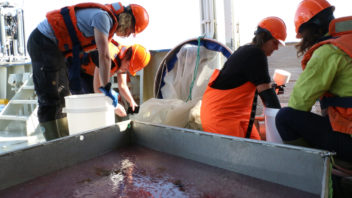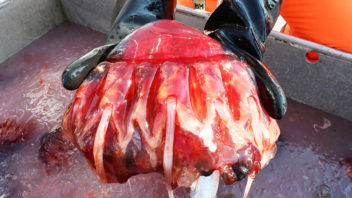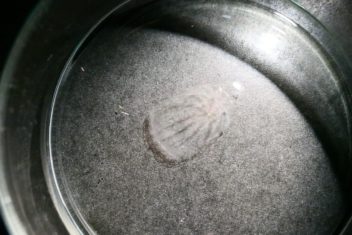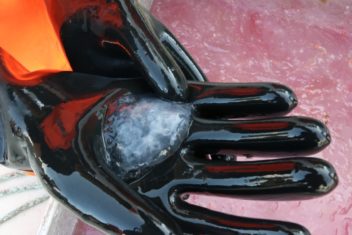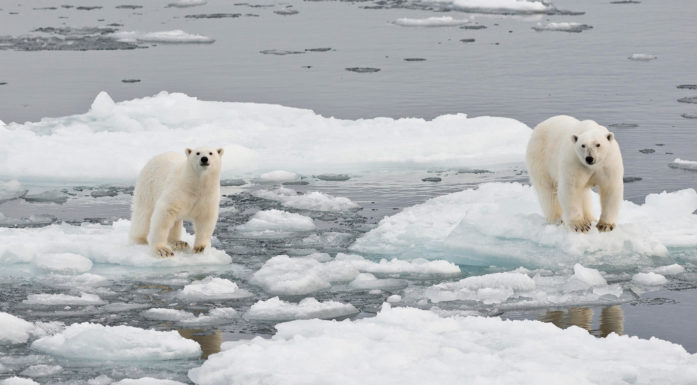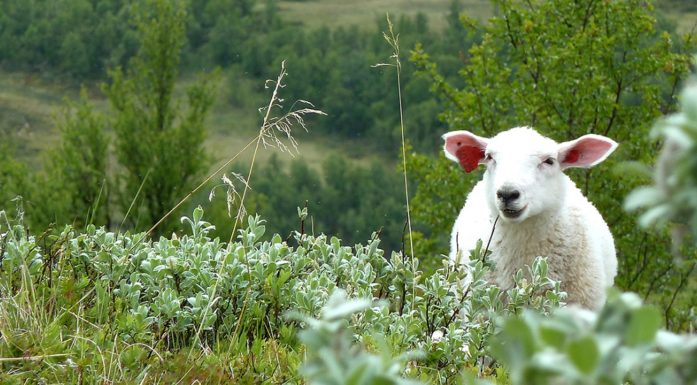A day in the life of a jellyfish hunter
The oceans are teeming with ever-increasing numbers of jellyfish. These squishy sea creatures can ruin fishing and discourage tourists. But one research group wants to turn this nuisance into pay dirt.
ON THE RV GUNNERUS, TRONDHEIM FJORD: There’s just no polite way to say it: A net full of jellyfish dumped into a big metal vat looks like snot.
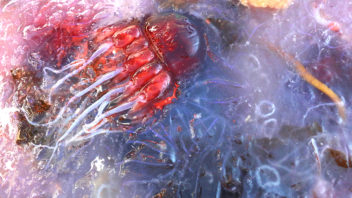
Yes, it’s just as quivering and gooey as it looks. But some of these jellyfish also have stinging tentacles. Photo: Nancy Bazilchuk/NTNU
No, that’s not quite right: It looks like the most disgusting combination of snot, vomit, and something you cough out of your lungs that you can possibly imagine.
That doesn’t stop researcher and biologist Nicole Aberle-Malzahn from plunging her hands into this goopy mess to pull out some of the larger, slimier representatives of the species.
Unloved, and mostly thought of as a nuisance, jellyfish are increasingly of interest to both researchers and industry. This is partly due to necessity: there can be so many jellyfish in some areas that they clog the nets of fisherfolk, making it difficult for them to make a living. In Norway, jellyfish can cause major health problems on salmon farms, with huge financial losses. And too many jellyfish in the waters off tourist havens can discourage visitors, with dire economic consequences.
Turn this thinking on its head, though. Jellyfish could also be a valuable resource in and of themselves, either for people to eat or for their gelatinous mantles, which can be used for everything from making cosmetics to sieving microplastic bits from water.
And then, there are the biologists.
“I think they are fascinating,” says Sanna Majaneva, a postdoc at NTNU and at UiT The Arctic University of Norway. “They are an ignored part of the food web. They’re thought of as just being water. And because jellyfish blooms are a natural phenomenon, they have to have an impact on the food web, they have to have a role.”
- You may also like: Jellyfish invaders: Trondheim Fjord in transition
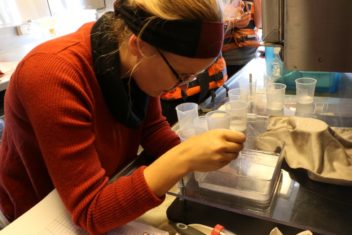
Sanna Majaneva, a postdoc with a shared position at NTNU and at UiT – the Arctic University of Norway, looks for small jellyfish. Photo: Nancy Bazilchuk/NTNU
Commercializing jellyfish
Aberle-Malzahn, an associate professor at NTNU’s Department of Biology, Majaneva and the half-dozen other researchers on NTNU’s R/V Gunnerus are part of a European-wide project called GoJelly.
The Norwegian-based team is one of 15 scientific institutions from 8 countries involved in the EUR 6 million project, coordinated by the GEOMAR Helmholtz Centre for Ocean Research Kiel in Germany, and funded by the EU’s Horizon 2020 programme.
Article continues under photo.
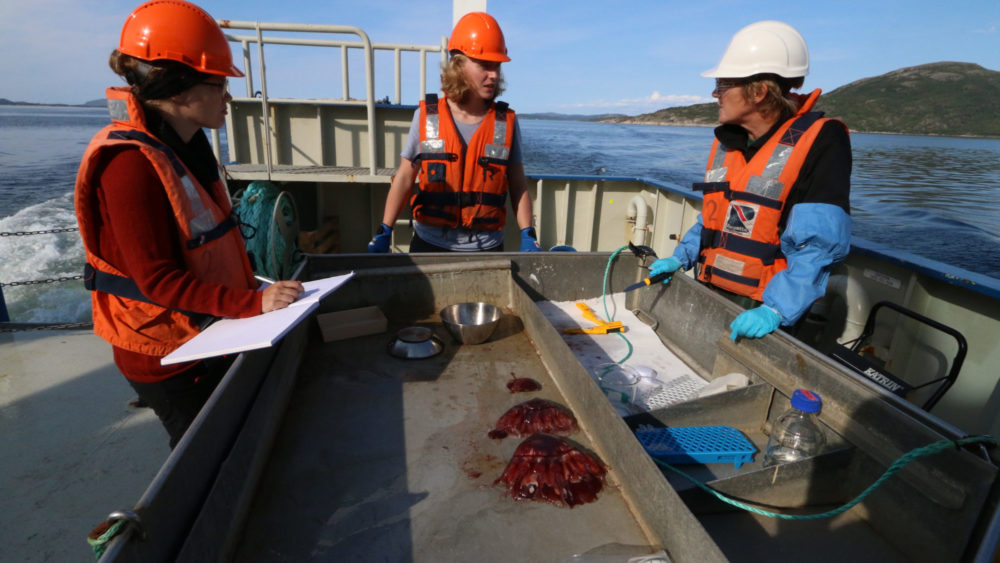
Each of the larger jellyfish species is weighed, measured and sampled for DNA and other information. From left, Sanna Majaneva, Matias Rekstad, Mari-Ann Østensen. Photo: Nancy Bazilchuk/NTNU
The day’s assignment aboard the Gunnerus is to hunt for adult jellyfish, with the hopes of catching as many as they can scoop up in a net trawled off the back of the research vessel in about 200 metres of water. The ship is roughly a two-hour cruise from Trondheim, on the outer edges of the fjord, where the Gunnerus crew thinks they’ll find their prey.
“GoJelly is tackling the challenges we are facing with increasing blooms of jellyfish, not only in European waters, but worldwide,” Aberle-Malzahn said. The project has a clear commercial goal, to develop a filter using the slime from jellyfish that can be used to capture microplastics.
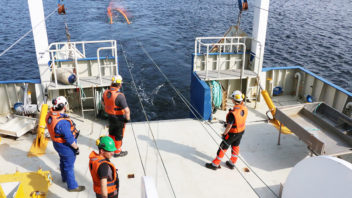
The crew of the RV Gunnerus hauls up a net full of jellyfish from Trondheim Fjord. Photo: Nancy Bazilchuk/NTNU
The researchers also want to better understand what other commercial products might be made from jellyfish. SINTEF Oceans, for example, is looking at what kinds of substances could be extracted from jellyfish for commercial use, from medicine to nutraceuticals to fertilizer. An important part of this task is to learn what causes jellyfish populations to boom.
Understanding this last factor could help fisherfolk who might be willing to tackle the seemingly unsavoury task of catching jellyfish, either as an off-season occupation or as a full-time job.
Unloved and poorly understood
Jellyfish are enough of an unloved species that their biology is relatively poorly understood — what exactly do they eat? How much do wind and water currents control their location? And most importantly, what causes their populations to grow explosively in some years and not others, and in some places but not others?
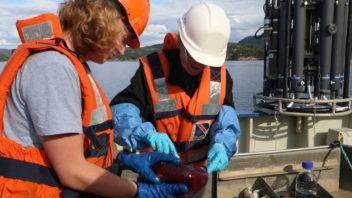
Matias Rekstad, an NTNU master’s student in biology, and Mari-Ann Østensen, senior engineer in the Department of Biology, examine a helmet jelly that looks like a giant heart. Photo: Nancy Bazilchuk/NTNU
“There are more and more blooms, and the sources and origins of these blooms are not quite clear,” Aberle-Malzhan said. “We’re trying to figure what are the factors that enhance growth, and cause jellyfish blooms in the late summer and early autumn. What are the factors that are beneficial for the mass occurrence of blooms — because there is a huge variation and intensity in them.”
That means the GoJelly team will use their time on the Gunnerus to collect all kinds of information to find the answers to these questions.
- You may also like: Ocean prophets
Lion’s mane, moon jellies and helmet jellies
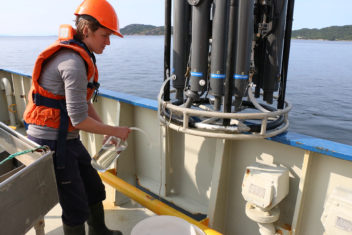
Angela Stippkugel, a PhD student in the Department of Biology, collects seawater samples from the CTD sampler on Trondheim Fjord. The sampler allows researchers to take seawater samples at different depths so they can know more about the characteristics of the water throughout the entire water column. Photo: Nancy Bazilchuk/NTNU
The researchers are specifically looking at the lion’s mane jellyfish, Cyanea capillata; moon jellyfish, Aurelia aurita; and the helmet jellyfish, Periphylla periphylla. They are also interested in comb jellies, known by their generic name, ctenophores, but these creatures are not the priority for the day’s cruise
They’ll collect basic information about the seawater where they harvest their jellyfish samples, such as temperature, salinity and nutrients in the water.
This last is an important measure of the amount of nutrients there are in the water for phytoplankton, which are the plankton at the very bottom of the food chain. They’ll also measure something called seston, which gives the researchers an idea of the food quantity and quality that’s available from all the plankton in the water.
But those are just the basics. The cool stuff happens when they drop the long trawl net at their sample site and pull it along the bottom for 20 minutes or so, and then slowly haul it up.
- You may also like: Researchers are hunting microplastics with jellyfish
No big splat, but big gooey bits
Parts of the innermost area of Trondheimfjord can be so full of jellyfish, driven there by winds and waves, that there is concern that jellies could actually displace cod as the top predator in the food chain. But on this day, the Gunnerus is in the very outermost reaches of the fjord, in the last protected arm before the land gives way to the open sea.
That means when the net comes up from the bottom with its jellyfish captives, it won’t be bulging with helmet jellies, Aberle-Malzahn says.
“There won’t be a big splat when we open the net,” she said. “There will be lots of jellies, but the net won’t be completely full.”
Nevertheless, when the green trawl net is hauled aboard, it’s glistening and bulging, and when the Gunnerus crew pulls the cord on the bottom of the net, a big rush of jellyfish-laden water pours out.
Big gloves sometimes a necessity
Much of what tumbles into the metal sorting vat is clear and glistening, made up of comb jellies and moon jellies. Here and there are the triangular-shaped helmet jellyfish, big as a piece of toast. They gleam red in the sun, like oversized cherry-coloured throat lozenges. The few lion’s mane jellies are big, tan and sticky looking, as if they have been coughed up with difficulty by a heavy smoker. Long slimy bits of jellyfish hang off the sides of the net like snot dripping from the nose of a toddler.
The crew is undaunted.
They eagerly reach into the vat and start sorting out the jellyfish by species. The lion’s mane jellyfish is the only one that has stinging tentacles with any power, so most of the jellies can be picked out of the vat wearing regular rubber gloves. Only Aberle-Matzahn has elbow-length black gloves, so she is mostly delegated to pluck the stinging jellies out from the gruesome soup.
At one point Matias Einar Rekstad, a master’s student who is studying the life cycle of the moon and lion’s mane jellyfish, decides he’ll try to pick one up anyway.
“Auuugh!” he says, as it slithers out of his hands in a soft, gloppy mess. “I need some bigger gloves to take this one!”
Genetic backtracking
Once the contents of the vat are sorted, the helmet jellyfish and lion’s mane jellyfish are measured and sampled. The samples are for genetic analysis, in part for Majaneva’s piece of the research project. She is studying the population genetics and connections between the different species of adult jellyfish and their younger selves, called polyps.
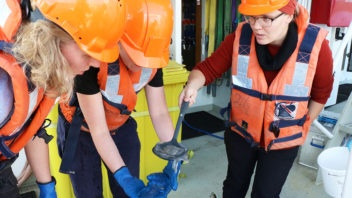
Sanna Majaneva, a postdoc at NTNU and at UiT – the Arctic University of Norway, ladles moon jellies out of the vat and into waiting hands. Photo: Nancy Bazilchuk/NTNU
“What we would like to know is, what is the origin of the blooms?” she said. “We regularly see blooms of adults, but what is not known is where are the polyp stages, what is the connectivity, how far from their origins do they drift?”
Majaneva and her colleagues have been collecting polyps and adults in different locations, and a computer model for the fjord developed by their Sintef Ocean colleagues should help them understand how currents move the jellyfish around.
“Then we try to put all these factors together to find out the connectivity,” she said. “It’s interesting, because we detect the blooms regularly, and for different species in different locations and at different times of year, but we still don’t know where they are coming from.”
Understanding what causes the jellyfish blooms and where they are likely to form is critical to developing any future harvest of the sea creatures, Majaneva said. For one, if researchers can predict where the blooms are likely to occur, it makes it more economical for fisherfolk to catch them.
“If we do start harvesting them, we have to do it ecologically,” she said. “If we understand what drives the blooms and how they are formed, we can harvest them in a more sustainable way.”
Fascinating species
Not all the research on this cruise has to do with harvesting jellyfish, however. Ellie Johansen, a master’s student in the Department of Biology, is working on a project funded by the Norwegian Biodiversity Information Centre, “GooseAlien: Ctenophores – native aliens in Norwegian waters.” Her supervisors are Majaneva and Aberle-Malzahn.
So while most of the crew is out on the sunny deck, sorting through jellyfish, Johansen is in a lab inside the boat, in the partial dark as she photographs comb jellies through a microscope. These jellyfish are also called sea gooseberries, because of their appearance, or ctenophores, after their Latin name.
She is also collecting DNA from the jellies to create a better database for identifying them, and mapping their occurrence and diversity along the Norwegian coast, partly with the help of local “citizen scientist” divers.
“By careful morphological identification of fresh individuals, collecting DNA and good photographs of the ctenophores I hope to map their poorly understood diversity, and smooth the way for easier future identification” she said.
The comb jellies are especially challenging to study because they are so fragile, and hauling them up out of the depths in a big net bag can crush or destroy the animals. At the same time many of the chemicals used to preserve zooplankton cause distortion and shrinkage of their gelatinous bodies. But Johansen and others on the cruise are eager to learn more about what they see as fascinating creatures.
That was the feeling of Rekstad, whose work with moon and lion’s mane jellyfish involves setting out plates in the ocean to see where jellyfish polyps actually settle so that he can better understand their lifecycle.
“They’re amazing,” he said. “They haven’t really changed in millions of years.”
References:
Halsband, C., Majaneva, S. K., Hosia, A., Emaus, P., Gaardsted, F., Zhou, Q., Nøst, O. A. & Renaud, P. E. (2017). Jellyfish summer distribution, diversity and impact on fish farms in a Nordic fjord. Marine Ecology Progress Series, 591, 267-279.
(2017) Coming Soon to a Fjord Near You: Future Jellyfish Scenarios in a Changing Climate, Coastal Management, 45:1, 1-23, DOI: 10.1080/08920753.2017.1237239

